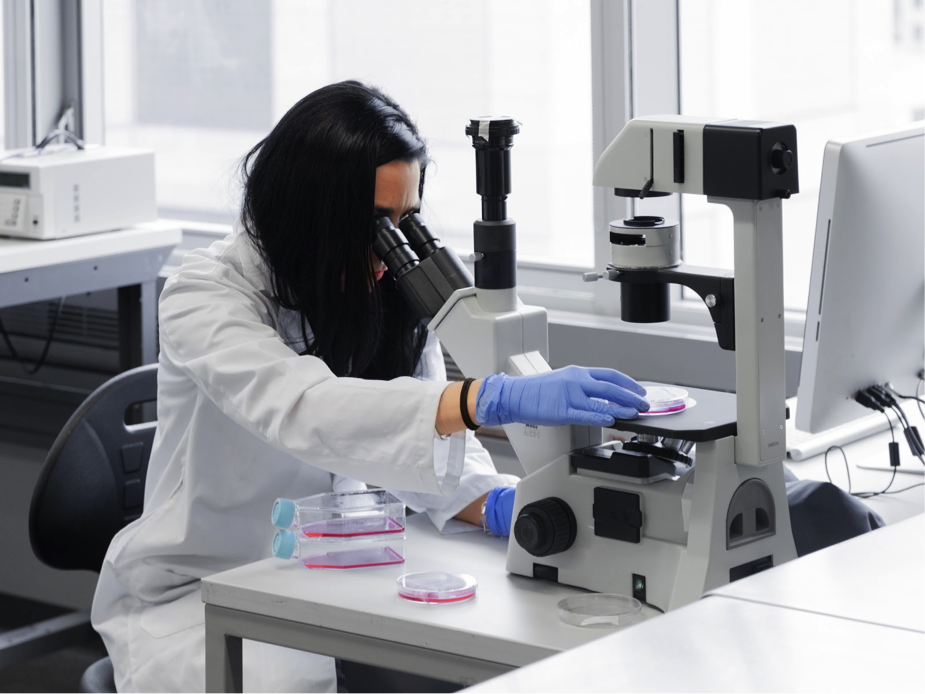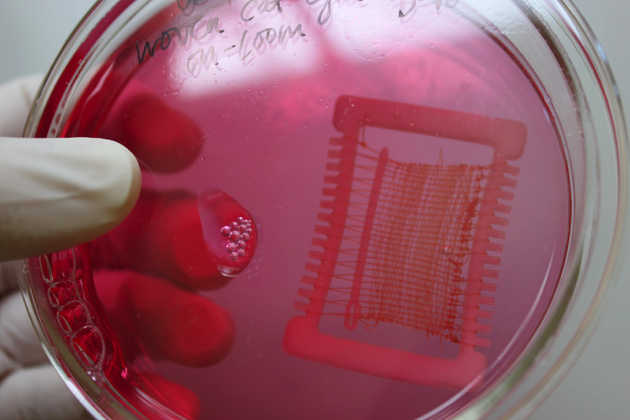Recent Articles
Categories
To the average person, science and art are two directly opposing fields. At first glance, science seems as if it is solely concerned with empirical facts and research, while art seemingly has little application outside of creative expression. However, upon taking a deeper look, it is difficult to imagine a world in which one could function without the other. Historically speaking, the segregation between the arts and science is a relatively recent phenomenon. As many have come to learn, scientific discovery often requires some artistry and creativity, while for many, the artistic process can be boiled down to an exact science. One local artist and researcher, WhiteFeather Hunter, embodies this union flawlessly.
WhiteFeather Hunter is an unorthodox interdisciplinary artist whose artistic medium is live organisms. Hunter traded in the studio life for a lab coat, pipettes and petri; she is a champion and a pioneer in the field of Bio Art in Canada. What at the outset seems to be an oxymoron, “Bio Art” combines two typically segregated subjects and uses techniques from both fields to create semi-living works of art. WhiteFeather rightly advocates that Bio Art offers a different perspective when it comes to the way we traditionally think about the arts and sciences and the interesting things that happen when they overlap.
WhiteFeather working in the lab (by Matthew Brooks for Milieux Institute)
Hunter’s career path originates from a fine arts background. She most recently completed her Masters degree in Fine Arts, with a specialization in textiles and materials. WhiteFeather was already known for using body tissues in her artwork such as hair, skin, etc. Her bio art background, however, is a more recent addition to her skill set.
One day, she stumbled upon a notice for a tissue engineering course at the University of Ottawa that piqued her creative interests. With no applicable science background, she decided to put in for a seat in the workshop for fun. Not thinking she would be accepted, she was pleasantly surprised when she was selected to participate in the course, which was taught by the director of SymbioticA--the world’s most prestigious Bio Art institute, located in Australia. The director explained that the course was meant to target participants with a creative background, which meant Hunter was the perfect fit.
WhiteFeather immediately fell in love with the work, which quickly became her passion. In 2014, she was invited for a residency at SymbioticA, to do research which later became her thesis work. Upon completion of her Masters, she became a founding member and the Principal Investigator of a new Bio Art lab at Concordia University in Montreal.
A typical day in the lab for Hunter begins when she puts on her lab coat--atypical for an artist. For the past five years, she has been working on three projects, all of which involve living organisms which are used to develop textiles (art pieces constructed of natural or synthetic fibers, used in decorative and practical applications). Her first, and biggest project uses mammalian cells (human and animal), grown on textiles to make live tissues. The cells take over the textiles to form a kind of skin. The second project uses bacteria that produce pigment. These pigments are then used to dye fabrics. The bacteria produce the primary colours. The third project involves bacteria and yeast. It begins with with fermentation, a process used to manufacture kombucha. A thick layer of cellulose develops on top that looks like a mushroom. This layer is called the “mother”, which can be dried out and used to make textiles. Caring for the cells and bacteria, like any living creatures, can be tedious and this presents a unique challenge that is foreign to most artists. Hunter must not only be concerned with the appearance of her work, rather she must also maintain an ideal environment in which her art can live.
Kombucha garment, called Bucci, is a collaborative work with biodesigner, Théo Chauvirey (photo by WhiteFeather)
Instead of picking up her materials from an art supply store, Hunter must make nutrient media for these organisms, check their incubators, and when their needs are not being met, she like her bacteria must adapt in order to preserve her creation. WhiteFeather brings an entirely new meaning to “artistic collaboration” as she not only works alongside her peers, but she also “co-creates” with the bacterial colonies she manipulates. WhiteFeather uses the term co-creation to describe the ways in which the bacterial species adapt and react to her manipulation, which sometimes can occur in surprising ways.
Bacteria-dyed swatches are experiments with Serratia marcescens (sp.) as part of WhiteFeather’s collaborative research with Alex Bachmayer, Vanessa Mardirossian and Gen Moisan
Bio Art is a relatively experimental field of research. Unlike most scientific work, many of the conducted experiments are made up by the researchers and not often repeated. The experiments can also fail but, WhiteFeather proudly presents her work regardless since failures can be just as interesting. These projects require practical scientific knowledge, as well as creativity and experimentation. Since her artistic creations are live, Hunter must also get creative when it comes to displaying her work. Traditionally, art is associated with permanence. This presents a challenge to WhiteFeather as her art exists during an ephemeral window of time and can be altered at a moment’s notice. In light of this, WhiteFeather presents her work as temporary objects, process video, and photographed exhibits at galleries so that the art she creates can be digitally preserved. She often shares her work, and has been featured in scientific journals, books and magazines. She aims to demonstrate to the public the intricacies of biological science and the versatility of artistic practice.
Biotextile in the petri dish (by WhiteFeather)
Through this career, WhiteFeather has been given ample opportunity to travel to present her work and complete residencies, as until recently there were no official Bio Art institutions in Canada. She has participated in residencies in Finland (Lapland/ Sápmi), Iceland, Denmark, France and Australia. She has also presented her work in Berlin, Austria, England, New Zealand and Belgium. WhiteFeather passes along her acquired skills to others in workshops to get more people involved and spread awareness about Bio Art. She hopes to build a strong Bio Art community as the domain grows. There are also biomedical applications in her work, but this is not her primary focus.
WhiteFeather aspires to continue her work in this field, as there is still so much to learn. To her, a big part of the excitement that comes with her job is in the fact that she has the opportunity to be a pioneer in her field. For WhiteFeather, every day presents a new set of opportunities and experiences, while many other scientists are attempting to recreate old experiments. She says it much more exciting to be the inventor.
As of January 15, 2019, WhiteFeather has been working towards a PhD in Bio Art through the schools of Design and Human Sciences at the University of Western Australia. This program will take three or four years to complete and it is both theoretical and practice based, which means she gets to continue her work in the lab. Hunter enjoys doing the unexpected, and disrupting preconceived notions about art and science alike. She often surprises people with her knowledge, and enjoys the positive feedback she receives from those interested in her field. Her favourite part about her work is that there are not many women in the bioengineering field, making it an empowering feminist thing to do. WhiteFeather states that,
“Women have unique perspectives to offer the worlds of science, technology, engineering and math (STEM). I’m interested in expanding those fields to include Art as both a disruptive and complementary field, which will generate new forms of knowledge and shake up science as we’ve known it, while providing more entry points to women who are passionate about research and creation.”










